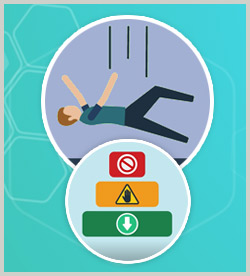Emergency and Disaster Preparedness and Response - Australia
- 5 topics | 22m 1s
- Up to 30 languages
- Transcripts
Emergencies and disasters can strike at any time, anywhere, and without any warning. In this course, you'll learn about ways to prepare and respond to emergencies and disasters. You'll also learn about safe evacuation practices. Then you'll be introduced to the best ways to respond to specific natural and manmade emergencies and disasters. This course was designed and developed to provide instruction on emergency response, safety, reporting and evacuation of company facilities and work areas in the event of a natural disaster, fire, bomb threat or other emergency. The procedures and advice provided reflect requirements set down by Australian state and territory work health and safety authorities. Always refer to your state or territory’s specific requirements along with the plans and processes provided to you by your employer. In all circumstances, follow the directions of emergency services personnel. These course materials and content are for informational purposes only and do not constitute legal advice. Nothing herein, or in the course materials, shall be construed as professional advice as to any particular situation or constitute a legal opinion with respect to compliance with any federal, state, or local laws. Transmission of the information is not intended to create, and receipt does not constitute, an attorney-client relationship. Readers should not act upon this information without seeking professional counsel. The information contained herein is provided only as general information that may or may not reflect the most current legal developments. This information is not provided in the course of an attorney-client relationship and is not intended to constitute legal advice or to substitute for obtaining legal advice from an attorney licensed in your state.
WHAT YOU WILL LEARN
-
recognise best practices to demonstrate preparedness for an emergency or disaster
-
identify information that you need to know to be prepared for an emergency evacuation
-
identify the actions to take in the event of a fire
-
identify the actions to take in the event of a hazardous chemical spill or release
-
identify the actions to take in the event of an earthquake
-
identify the actions to take in the event of a flash flood
-
identify the actions to take in the event of a cyclone
-
identify violent behaviour and warning signs of violent behaviour
-
recognise the preferred course of action to take in an active armed offender situation
-
identify the appropriate response to a bomb threat
IN THIS COURSE
-
Preparing an Emergency Response5m
-
Surviving an Emergency3m
-
Responding to Fires and Chemical Spills3m
-
Responding to Specific Natural Disasters4m
-
Responding to Violence and Threats in the Workplace3m
YOU MIGHT ALSO LIKE
COMPLIANCE-COURSE
Managing the Risk of Falls – Australia
COMPLIANCE-COURSE
Back Safety and Injury Prevention - Australia
COMPLIANCE-COURSE
Workplace Health and Safety Essentials – Australia


